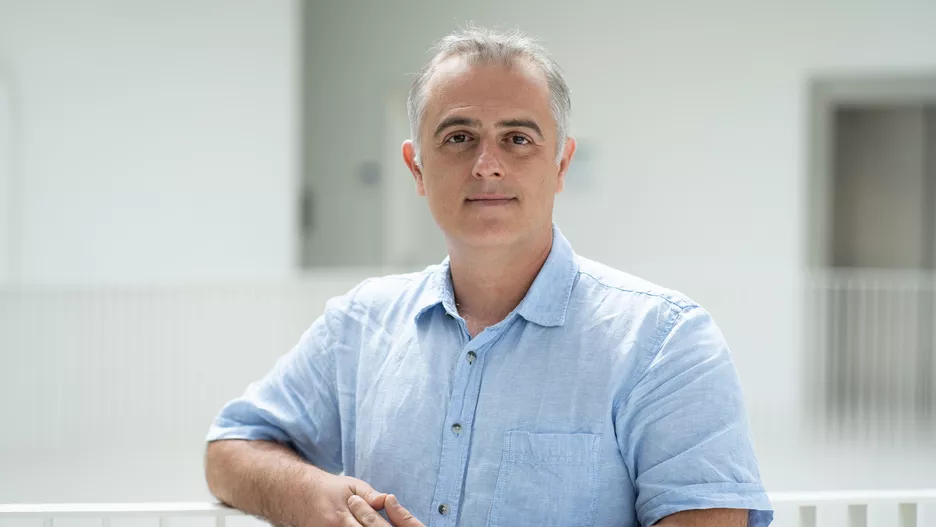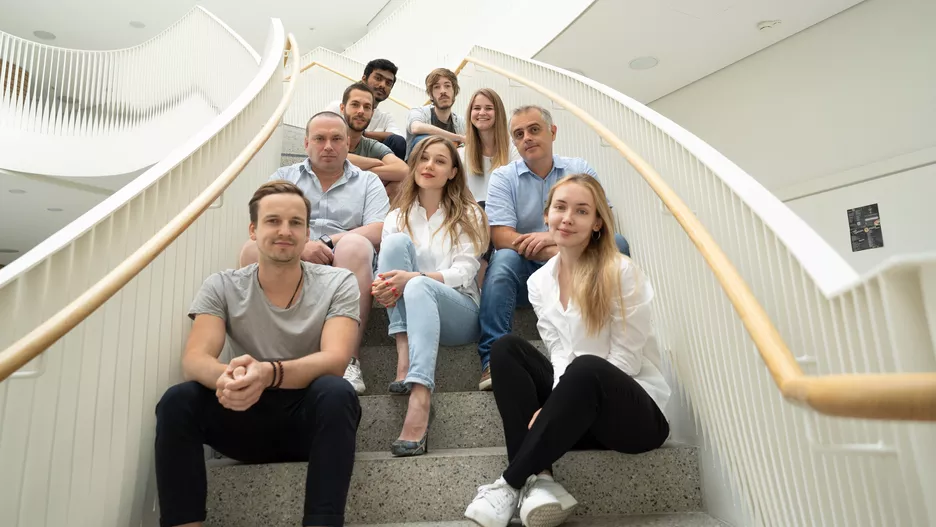This content is only available in English
Dimitris Gorpas - Fluorescence Imaging

Research Focus
We develop advanced methods for pre-clinical and clinical imaging. In 2011, our work led to the first clinical translation of a targeted fluorescent agent for fluorescence molecular imaging in patients. Our focus is the development of quantitative methods that go well beyond conventional "photographic" fluorescence imaging, as well as the validation of fluorescent agents. Particular areas of focus are:
1. Real-time fluorescence molecular imaging and endoscopy
We develop real-time fluorescence molecular imaging and endoscopic systems, methods to improve lesion identification and accurate demarcation of cancer margins. This research is geared toward novel multi-spectral instrumentation and the use of appropriate fluorescent agents with clinical relevance. We intensively explore inflammation and gastrointestinal cancers, as early detection is anticipated to have a tremendous impact on disease prognosis and healthcare. Towards this end, we have been awarded grants to systematically explore the value that fluorescence molecular endoscopy and optical spectroscopy can add to standard clinical practice.
2. Fluorescence and color cryoslicing
We develop robust, multi-spectral approaches for automatic imaging of tissues during cryoslicing. Current research pursues hardware optimization and development of imaging methods to correct for photon scattering. Additionally, in close collaboration with other groups, we employ multi-spectral cryoslicing technology to provide answers to clinically and biologically relevant questions.
3. Standardization and benchmarking
We develop algorithms and phantoms for the standardization of fluorescence imaging systems. Our group is one of the leading centers worldwide that has systematically been working towards the high-fidelity fluorescence molecular imaging. We are closely working with numerous groups to enable comparative clinical studies, optimized development of imaging systems, and performance assessment of existing ones.
4. Intravascular NIRF-IVUS imaging
We develop hybrid intravascular ultrasound (IVUS) and near-infrared fluorescence (NIRF) catheters and methods that enable concurrent imaging of cardiovascular disease-related morphological and biological alterations. We have developed advanced peripheral and coronary hybrid catheters. Correction algorithms utilizing IVUS and optoacoustics information are investigated to account for the distance-related fluorescence attenuation.
5. Hybrid FMT/XCT imaging
We develop robust hybrid fluorescence molecular tomography (FMT) and X-ray computed tomography (XCT) imaging systems and inversion methods using priors for quantitative in vivo molecular imaging in small animals. We systematically investigate biologically relevant questions and drug discovery, while also improving current technology. We recently received funding to move well beyond the current state-of-the-art by shifting from the near infrared regime to that of shortwave infrared, which we anticipate will improve the accuracy of reconstruction and quantification.

Dr. Dimitris Gorpas studied Electrical and Computer Engineering in the Department of Electrical and Computer Engineering at the Technical University of Athens, Greece. After his graduation, he obtained a Ph.D. in Engineering from the same institution. He went on to work as a postdoctoral research fellow to the Information Technologies Institute, Centre for Research and Technology, Hellas, Thessaloniki, Greece. In 2013, he moved to the Department of Biomedical Engineering at the University of California, Davis as a postdoctoral research employee. Since 2016, he is leading the Fluorescence Imaging group at the Chair of Biological Imaging and Center for Translational Cancer Research (TranslaTUM) of the Technical University of Munich, as well as the affiliated Institute for Biological and Medical Imaging at the Helmholtz Zentrum München. His scientific interests include the development of medical intraoperative and endoscopic imaging systems, their clinical validation, and surgical guidance through optical measurements. The aim of this research is to improve understanding of optical properties of tissue and their variation in relation to structural, molecular, and biochemical or functional parameters. The ultimate goal is the development of comprehensive imaging technologies to provide physicians innovative tools for diagnostic and therapeutic purposes.
- Recipient of special payment for outstanding scientific performance in 2018, Helmholtz Zentrum München, Munich, Germany (2019)
- Award for "Excellence in Leadership and Grantsmanship", Institute of Biological and Medical Imaging, Helmholtz Zentrum München, Munich, Germany (2018)
- International SPIE Scholarship in Optical Science and Engineering (2009)
- Various scholarships from the Institute of Communication and Computer Systems (ICCS), National Technical University of Athens, Athens, Greece (2003-2009)
- "Progress of Science" awards for various publications, Thomaidio Foundation, National Technical University of Athens, Greece (2005-2008)
Sterkenburg, A.J., Hooghiemstra, W.T.R., Schmidt, I., Ntziachristos, V., Nagengast, W.B., Gorpas, D. (2022). Standardization and implementation of fluorescence molecular endoscopy in the clinic. J Biomed Opt 27, 1-14.
Fang, H.-Y., Stangl, S., Marcazzan, S., Carvalho, M.J.B., Baumeister, T., Anand, A., Strangmann, J., Huspenina, J.S., Wang, T.C., Schmid, R.M., Feith, M., Friess, H., Ntziachristos, V., Multhoff, G., Gorpas, D., Quante, M. (2022). Targeted Hsp70 fluorescence molecular endoscopy detects dysplasia in Barrett’s esophagus. Eur J Nucl Med Mol Imaging 49, 2049-2063.
Gorpas, D., Koch, M., Anastasopoulou, M., Bozhko, D., Klemm, U., Nieberler, M., Ntziachristos, V. (2020). Multi-Parametric Standardization of Fluorescence Imaging Systems Based on a Composite Phantom. IEEE Trans Biomed Eng 67, 185-192.
Nagengast, W.B., Hartmans, E., Garcia-Allende, P.B., Peters, F.T.M., Linssen, M.D., Koch, M., Koller, M., Tjalma, J.J.J., Karrenbeld, A., Jorritsma-Smit, A., Kleibeuker, J.H., van Dam, G.M., Ntziachristos, V. (2019). Near-infrared fluorescence molecular endoscopy detects dysplastic oesophageal lesions using topical and systemic tracer of vascular endothelial growth factor A. Gut 68, 7-10.
Gorpas, D., Phipps, J., Bec, J., Ma, D., Dochow, S., Yankelevich, D., Sorger, J., Popp, J., Bewley, A., Gandour-Edwards, R., Marcu, L., Farwell, D.G. (2019). Autofluorescence lifetime augmented reality as a means for real-time robotic surgery guidance in human patients. Sci Rep 9, 1187.
Bozhko, D., Karlas, A., Gorpas, D., Ntziachristos, V. (2018). Optoacoustic sensing of hematocrit to improve the accuracy of hybrid fluorescence-ultrasound intravascular imaging. J Biophotonics 11, e201700255.
Pogue, B.W., Zhu, T.C., Ntziachristos, V., Paulsen, K.D., Wilson, B.C., Pfefer, J., Nordstrom, R.J., Litorja, M., Wabnitz, H., Chen, Y., Gioux, S., Tromberg, B.J., Yodh, A.G. (2018). Fluorescence-guided surgery and intervention — An AAPM emerging technology blue paper. Med Phys 45, 2681-2688.
Koch, M., Symvoulidis, P., Ntziachristos, V. (2018). Tackling standardization in fluorescence molecular imaging. Nat Photonics 12, 505-515.
Koch, M., de Jong, J.S., Glatz, J., Symvoulidis, P., Lamberts, L.E., Adams, A.L.L., Kranendonk, M.E.G., Terwisscha van Scheltinga, A.G.T., Aichler, M., Jansen, L., de Vries, J., Lub-de Hooge, M.N., Schröder, C.P., Jorritsma-Smit, A., Linssen, M.D., de Boer, E., van der Vegt, B., Nagengast, W.B., Elias, S.G., Oliveira, S., Witkamp, A.J., Mali, W.P.T.M., Van der Wall, E., Garcia-Allende, P.B., van Diest, P.J., de Vries, E.G.E., Walch, A., van Dam, G.M., Ntziachristos, V. (2017). Threshold Analysis and Biodistribution of Fluorescently Labeled Bevacizumab in Human Breast Cancer. Cancer Res 77, 623-631.
Gorpas, D., Koch, M., Anastasopoulou, M., Klemm, U., Ntziachristos, V. (2017). Benchmarking of fluorescence cameras through the use of a composite phantom. J Biomed Opt 22, 016009.
Dr. Dimitris Gorpas
Technical University of Munich
Chair of Biological Imaging
Helmholtz Zentrum München
Institute of Biological and Medical Imaging
Phone:+49 89 4140 7210
E-Mail